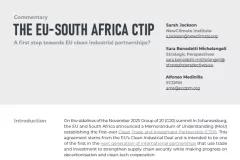Download the PDF version of the Q&A briefing here
This page is a Q&A briefing on the importance of 24/7 renewable electricity matching and the technical issues of the competing Emissions First Partnership proposals. This briefing is a collaboration between NewClimate Institute, ECOS, Beyond Fossil Fuels, Carbon Market Watch, Stand.Earth and Action Speaks Louder.
The Climate Group’s 24/7 Carbon-free Coalition, which is supported by Google, Vodafone, AstraZeneca and Iron Mountain Data Centers, among others, can guide companies to make serious contributions to the energy transition and to reduce their GHG emission footprints, by matching their electricity consumption to local renewable electricity generated on an hourly basis.
In contrast, the Emissions First Partnership (EFP) championed by Amazon and Meta, among others, proposes a loosening of the current rules. Key aspects of the EFP proposal can fundamentally be considered a simple repackaging of the controversial offsetting model; this would legitimise loopholes and let major companies off the hook for tackling challenging yet key emission sources, distracting and delaying from real climate action.
The trivialised notion that this is a choice between focusing on clean and dirty grids is not an accurate reflection of the situation or the challenges of the energy transition: the largest electricity consumers need to take responsibility to cooperate and overcome the significant challenges to decarbonising the grids that they use, which increase at deeper levels of decarbonisation.
(Last updated: October 2024)
What is the GHG Protocol and what is the importance of its revision?
The GHG Protocol is currently going through its first significant revision in over a decade and the outcome will be instrumental in defining corporate climate ambition in the years to come. More specifically, the GHG Protocol’s Scope 2 Guidance, first published in 2015, sets out accounting rules for GHG emissions associated with electricity procurement, as well as other energy purchased by companies for their own use. The Guidance is highly influential for the transparency and integrity of corporate climate action, as it forms a foundation for most of the other voluntary initiatives and governmental legislations that make up the landscape of the global corporate climate accountability framework. In 2023, the GHG Protocol began a major revision of the standard, to be completed by late 2026. The Technical Working Groups of experts for Scope 2 will begin their work in October 2024. This revision offers the opportunity to course-correct and to improve accuracy, along with transparency in scope 2 emissions accounting.
Many actors are trying to inform and influence these processes, and renewable electricity accounting appears to be one of the most relevant and most contested issues. Companies and civil society are putting their weight behind fundamentally opposing proposals. Many academics and civil society groups are supporting a shift to more granular renewable electricity accounting, such as the Climate Group’s 24/7 Carbon-free Coalition, which is supported by Google, Vodafone, AstraZeneca and Iron Mountain Data Centers, among others. In contrast, the Emissions First Partnership championed by Amazon and Meta, among others, proposes a loosening of the current rules which we perceive to be more akin to conventional offsetting, with all its limitations. Recent media coverage from the Financial Times, MIT Technology Review, and others has shed light on the issues with the Emissions First proposals and the importance of getting the GHG Protocol update right.
Renewable electricity accounting is a critical issue not only for scope 2 but also scope 3 emissions. Electricity use is the largest emission source in companies’ value chain emissions footprints. The integrity of companies’ climate strategies will depend on the way in which these companies and their suppliers account for electricity consumption in the value chain and companies’ interventions to support suppliers’ use of renewable electricity.
What is 24/7 matching and how does it support the energy transition?
To limit global warming, all energy needs to be zero carbon. Companies can best contribute to decarbonising the electricity grid by matching their electricity consumption with renewable electricity generated on the local grid and on an hourly (24/7 matching hereafter) basis. The current GHG Protocol guidelines allow companies to match on an annual basis, and within far larger geographical regions. This means that companies can buy renewable electricity certificates when and where there is an abundance of renewable generation but rely on fossil-fuel intensive grids at times and places when renewable generation is low. For instance, a company with a PPA for a solar park does not receive sufficient electricity from this installation on cloudy days or during the night. Modelling research shows that 100% renewable electricity claims matched on an annual basis hardly led to the displacement of fossil fuels.
Matching electricity consumption with local renewable electricity on an hourly basis provides an important demand signal for additional and novel renewable energy generation and storage technologies required to completely decarbonise power systems. The hourly matching approach also requires companies to consider when to use electricity (i.e. when generation peaks) and may lead to efficiency improvements. Analysis from researchers at Tsinghua and Princeton University found that “hourly matched procurements reduce system-level emissions” and “increases the early uptake of advanced clean energy technologies”.
A 24/7 framework also creates the need for constructive advocacy and collaboration for conducive policies for renewable electricity. Progress in the development of renewable electricity policy for renewable electricity is largely dependent on governments having the support of major corporations that are the largest electricity consumers. This means that effective frameworks are those that incentivise companies to support and work with governments to remove barriers. For example, Google notes that its 24/7 matching targets require it to be particularly proactive in advocating for more regulatory support for renewable energy and next generation electricity transmission systems; the company is highly transparent in its advocacy related to renewable electricity through the publication of proposed policy roadmaps and its responses to consultations. By contrast, the EFP proposal to allow companies to offset electricity-related emissions through renewable energy projects in other regions could reduce incentives for the largest corporates to constructively advocate and collaborate for policy development in the regions where they operate, in particular those where sourcing renewables in hardest and hence the most work is needed.
Who is supporting the 24/7 approach?
The Climate Group 24/7 Carbon-Free coalition was launched in September 2024. Founding members include Google, Vodadone, AstraZeneca, AirTrunk, Iron Mountain Data Centers and Shree Cement. The announcement is significant, since The Climate Group is one of the founding members of the RE100 initiative, which is one of the most influential global initiatives for mobilising companies to set renewable electricity targets. The Climate Group 24/7 Carbon-Free coalition is developing more specific technical criteria for 24/7 accounting which it plans to publish in the near future. This technical criteria could serve as a concrete framework for the GHG Protocol and the Science Based Targets initiative (SBTi).
Companies like Google and Microsoft had already been front-runners for moving from annual matching to 24/7 matching and have set corresponding targets. While these companies are moving in the right direction, their 24/7 targets also entail significant limitations for renewable electricity, as they are based on carbon free energy (CFE), instead of renewable energy. This means that those companies’ targets may allow for (existing and new) nuclear power and fossil fuels with carbon capture and storage (CCS). Nuclear power and CCS pose various environmental and social limitations, and their costs are substantially higher than some renewable generation technologies. Banking on nuclear capacity carries the risk of delaying investments in renewable capacity that needs to be developed in the near future to achieve sectoral decarbonisation benchmarks for the power sector. Attention also needs to be paid to how data centers expand and the challenges this will place on grids in the coming years. Partly due to the rapid expansion of artificial intelligence services, companies like Google and Microsoft continue to build and expand data centers. Although these companies have the aim to run data centers on 24/7 carbon free energy in the future, their substantial energy demand risks causing expansion and lock-in of fossil fuel generation technologies in the meantime.
What is the Emissions First Partnership?
Amazon and Meta co-founded the Emissions First Partnership (EFP), together with 8 other companies (i.e. Akamai, General Motors, HASI, HEINEKEN, Intel, Rivian, Salesforce, Workday) to advocate for accounting based on the metric of avoided or reduced emissions as an alternative to matching electricity consumption with renewable electricity generation. The EFP is not intended to replace the GHG Protocol, but it is rather a partnership of companies behind one conceptual idea trying to push this into the GHG Protocol.
EFP made a formal submission to the GHG Protocol revision process, related to Scope 2 Guidance. EFP’s proposal is two-fold. It first suggests accounting electricity-related emissions based on estimated avoided emissions in tonnes of CO2e to circumvent the need for further granularity in locality and time when using MWh as a metric for accounting. In addition, EFP proposes a complete removal of geographic boundaries for renewable electricity procurement: a data center in Virginia, US could be “decarbonized” using certificates purchased in Australia under this approach. We do not consider either of these proposals to be a credible approach to take responsibility for the decarbonisation of the electricity system. Rather, key aspects of the proposal can fundamentally be considered a simple repackaging of the controversial offsetting model, without even a proof of additionality. “It’s an offsetting scheme at its core,” concluded Wilson Ricks from Princeton University, who have published extensive peer-reviewed analysis on these competing proposals: Tsinghua University and Princeton University researchers found that Annually matched clean power procurements have negligible emission benefits and Strategies based on short-run marginal emission offsetting are similarly ineffective, because it rarely helps get projects built or clean energy generated where those things wouldn’t have happened anyway. This type of approach may let companies off the hook for addressing their responsibilities in the energy transition by claiming to be zero emissions on paper, while continuing to emit in practice. This is further unpacked in the following questions.
Why is it problematic to shift from matching kWh to accounting based on avoided or reduced emissions?
Through this proposed method, companies could claim a disproportionately large reduction in their electricity-related emissions, compared to the projects they implement. In current accounting practices, companies may use Energy Attribute Certificates (such as RECs) to offset their renewable electricity emissions, by matching 1 EAC derived from a renewable electricity project to 1 MWh of the companies’ non-renewable electricity consumption. The EFP’s proposal correctly identifies that accounting electricity emissions using MWh entails serious limitations if the location and time of RE generation and consumption are not considered. However, instead of addressing these limitations through increased granularity (as other companies, governments and experts propose), the EFP’s proposal advocates to move from matching units of electricity (MWh) to accounting the impact of renewable electricity projects in terms of avoided GHG emissions: 1 MWh of renewable electricity could lead to the avoidance of less than 0.1 tCO2e in one region, or nearly 1 tCO2e in another region, depending on the current state of electricity generation on that grid, and the type of marginal generation that the renewable project would in theory replace. In practice, this is likely to lead to the situation where the cheapest and lowest-effort interventions would count for the most, despite having little real world impact. Peer-reviewed research from Princeton University researchers has found that for the US case, this accounting does not work, concluding that strategies based on “marginal emission offsetting” are “ineffective”. For example, 1 MWh from a renewable electricity project in South Africa might offset 5-10 MWh of electricity consumption from a data centre in Silicon Valley or Seattle. This would drastically reduce the costs and real impacts associated with what companies need to do to make bold emission reduction claims, while relieving them of their important role to address the emission sources that they are actually responsible for.
The theory of offsetting to achieve the largest emission reductions at the lowest cost is disingenuous and has not worked in practice. Proponents of the EFP proposal would argue that a framework for companies to tap the lowest hanging fruit of emission reduction potential would actually be a good thing, on the basis that it makes it more affordable to meet and subsequently improve climate targets. However, we consider that this proposal is simply a repackaging of the outdated and controversial offsetting model, under which renewable energy projects have already been the mainstay of carbon crediting mechanisms for decades. A mounting volume of evidence from scientific analysis and investigative journalism shows that the climate impact of carbon crediting projects is often greatly exaggerated or even non-existent, while such projects are sometimes associated with human rights violations such as the forced removal of local populations. Amidst these concerns, the EU has moved to ban misleading green claims for products that are based on the purchase of carbon credits. In 2023, over 500 African civil society organisations came together to voice their opposition to carbon markets as a solution, stating that the model is “designed to encourage wealthy countries and people to continue polluting and turning Africa into a dumping ground and field for technological trials”. There is also no evidence that the procurement of standalone RECs untethered from the consumption temporally and geographically, in particular, has led to the development of additional renewable electricity capacity in major regions where these certification schemes have been operating for many years, according to studies.
Relying on counterfactual analysis to estimate avoided emissions is not a reliable basis for an accurate accounting system. Like other offsetting mechanisms, the Emissions First approach relies on a counterfactual analysis to estimate the avoided emissions of the renewable energy procurement by estimating the emissions of the marginal[1] generating plant at the time of renewable energy procurement. Put clearly, it’s an accounting methodology based on what did not happen, and hence can not be observed or verified in the real world, the issues of this type of accounting are well documented. This type of offsetting is not a reliable basis for an accurate accounting system. The short-run nature of the approach is also myopic, as it fails to capture the long-term effects so important for grid decarbonization and is “inadequate for assessing the full lifecycle emissions impacts”, as this critique in the Energy Policy Journal states.
Most critically, offsetting electricity emissions distracts from the urgency of emission reductions from electricity generation in industrialised economies, which is the last sector for which it could be reasonable to paper over the cracks and delay action. To maintain a chance of meeting the 1.5°C temperature limit, all sectors need to embark now on deep decarbonisation trajectories to reach net-zero GHG emissions and eventually net-negative GHG emissions worldwide (IPCC, 2018). In this ever more urgent context, there is no constructive role for accounting frameworks that distract from the need to address the challenging emission sources that companies are responsible for. This can only lead to delayed action, and potentially lock-in to further emission-intensive infrastructure developments in places where deep decarbonisation must be a priority. Most sector-specific scientific scenarios for keeping global warming well below 1.5 °C or 2 °C require electricity generation to reach deep levels of decarbonisation within the next decade, especially in industrialised economies. The International Energy Agency Net Zero by 2050 scenario finds that electricity generation in advanced economies must reach near zero emissions by 2030 and net zero emissions by 2035.
[1] In this context, the marginal plant means the plant that would have produced a unit of electricity if the unit of renewable electricity were not produced. Of course, this analysis can only be applied to marginal changes in renewable generation and not be used by all renewable energy at a given time to estimate their avoided emissions.
In what sense would the expansion of the geographical boundaries for renewable electricity procurement let major companies off the hook for addressing the significant challenges of their own grids?
EFP proposes a complete removal of geographic boundaries for renewable electricity procurement. This would reduce incentives for companies to contribute to solving the significant challenges for decarbonising their own grids. The EFP proposal claims that the current market boundary criteria fail to maximise the decarbonisation impact by requiring all instruments to be sourced from the same market in which companies operate. EFP argues this impedes the opportunity to accelerate RE in more carbon-intensive grids. As a result, EFP proposes to allow sourcing Energy Attribute Certificates (EACs) without geographic location limitation, to incentivise investments in RE in other markets, where the marginal costs of further renewable deployment are lower. In simple terms, this means companies could simply buy credits from renewable electricity projects on any other carbon-intensive grids, rather than decarbonise their own grids. This means they may not actually reduce their own carbon footprint, but instead, they claim to offset their emissions by investing in renewable energy elsewhere. While this might appear to support renewable energy projects, it doesn't lead to real emissions reductions in the areas where the electricity is consumed. It also ignores basic fundamentals of the power system: generation and load must balance in real time and grids are congested, meaning having a global boundary approach with no time-matching restrictions is no reflection of the real challenges the sector faces. This is especially critical in the context that the rapid construction and expansion of datacenters is placing new challenges on grids that may lead to investments and long-term lock-in to more fossil fuel generation capacity to address short-term power demand needs.
In contrast to the EFP proposal, the largest electricity consumers need to take responsibility to cooperate and overcome the challenges to decarbonising the grids that they use, which increase at deeper levels of decarbonisation. The complexity and marginal costs of grid decarbonisation increase at deeper levels of system decarbonisation i.e decarbonising the hours when there is low availability of wind and solar by making critical investments in storage and demand flexibility. The first steps to integrate modest shares of renewables into an electricity supply system can be achieved with relative ease and low costs. Reaching higher shares of renewable electricity generation creates significant complexities for the grid system operators to supply electricity where and when it is needed, due to the variability of solar and wind supply according to weather conditions. By comparison, fossil fuel generation plants can be switched on and off as and when needed. Decarbonising the electricity generation sector in advanced economies requires there being incentives for all major system stakeholders to cooperate and innovate to find effective solutions for smarter electricity transmission, storage and load balancing. Up to now, most of Amazon’s and Meta’s investments in renewable energy projects are located in the same regions as their major operations, in line with current GHG Protocol accounting requirements, though the grid boundaries have been drawn extremely wide and this has meant that renewable projects are often located extremely far from actual operations in practice. But as these companies’ energy needs are increasing, largely due to their race to expand AI infrastructure and build data centres, it is becoming increasingly difficult to source renewable energy on the grids where they operate, creating an incentive to look for renewable energy from other regions and have this count towards their emissions reduction goals. Yet it is important that major corporations placing growing demand on grids continue to play a key role in cooperating to address these infrastructural costs and challenges; the GHG Protocol revision should not allow them to avoid this responsibility by opting for easier solutions, such as buying cheaper EACs elsewhere.
What is the significance for companies' supply chains, and which framework is better placed to unlock the right investments in major manufacturing regions?
Much of the debate on renewable electricity claims focuses on companies’ own electricity consumption, but major corporations also need to step up their role in decarbonising their supply chains. Many major companies, including most of the EFP members, have significant scope 3 emissions, with greater electricity demand in their supply chains compared to their own operations. With around 18% of global energy-related emissions deriving from manufacturing, the achievement of the global climate change mitigation objectives as set out in the Paris Agreement, will depend to a large extent on the accelerated decarbonisation of the electricity grids in major manufacturing regions. Renewable energy remains very challenging and expensive to procure in some of these regions, often due to limitations of existing grid infrastructure and unconducive local policy frameworks. The capacities and influence of smaller suppliers to overcome these challenges is often limited. As such, the decarbonisation of supply chains requires that major companies work with their suppliers to clean the grids in the various regions where their manufacturing process takes place. For that, the companies need clear incentives.
Some promising examples including by Apple & Taiwan Semiconductor Manufacturing Company Ltd. (TSMC) are emerging to address supply chain challenges. A special edition report of the Corporate Climate Responsibility Monitor – Navigating the nuances of corporate renewable electricity procurement – showcased emerging case studies while noting their supply chain targets and measures also entail significant caveats.
24/7 matching can provide major corporations with clearer incentives to deepen supply-chain engagement to address complex challenges. If 24/7 matching would be the default framework for electricity-related emission accounting throughout supply chains, major companies would need to engage in much deeper and more constructive collaboration with suppliers to achieve real progress towards their lofty climate pledges. By contrast, if electricity-related emissions were accounted for according to EFP’s proposal, such companies may not have incentives to step up to the responsibility of these challenges, because it would be easier and cheaper to pick up the lowest hanging fruit in other regions. .
What to watch out for during the revision of the GHG Protocol accounting framework and the SBTi Corporate Net Zero Standard?
- The Climate Group 24/7 Carbon-Free coalition is developing more specific technical criteria for 24/7 accounting alongside leading academics and a technical group, which it plans to publish in the near future. This technical criteria could serve as a concrete framework for the GHG Protocol and the SBTi.
- Interactions between parallel GHG Protocol revision workstreams: The rules for accounting GHG emissions from energy in companies’ supply chains will depend largely on the scope 2 guidance revision process, especially for larger suppliers who set their own climate targets against their inventories. But supply chain action will also depend on parallel processes for the revision of GHG Protocol’s Scope 3 guidance and for an overarching workstream on market-based approaches, for which expert groups are also currently being formed.
- 24/7 renewable electricity should be one of the most important alignment targets under the SBTI’s revised Corporate Net Zero Standard, both for scope 2 and scope 3 emissions: We consider that the SBTi should take a more proactive stance on requiring companies to set the most effective and transparent targets for renewable electricity procurement, recognising that the current approach is very loosely defined and leaning on the outdated criteria of other initiatives (see Table 4; NewClimate Institute and Data-Driven EnviroLab, 2020). One of the SBTi’s stated objectives is to “define and promote best practice in emissions reductions and net-zero targets in line with climate science”. Promoting the best practice of 24/7 renewable electricity accounting may be the single most important measure that the SBTi could take towards this objective. The target setting approach under the Corporate Net Zero Standard should not necessarily be restrained by the GHG Protocol’s accounting guidance for scope 2 emissions, the revision of which will not be complete until at least late 2026. SBTi can require companies to set 24/7 renewable electricity targets for scope 2 and scope 3 emissions, even if the revised GHG Protocol guidance will not require a 24/7 accounting framework. Several of the SBTi’s existing target setting options are already unlinked to GHG inventories, and the SBTi Scope 3 Discussion Paper proposes to expand the use of such alignment targets that are related to specific outcome indicators, rather than GHG inventories.
NewClimate Institute is a not-for-profit research group and think tank based in Germany, well-recognised for its independent critical analysis of corporate climate action and carbon market mechanisms, such as the annual Corporate Climate Responsibility Monitor report.







